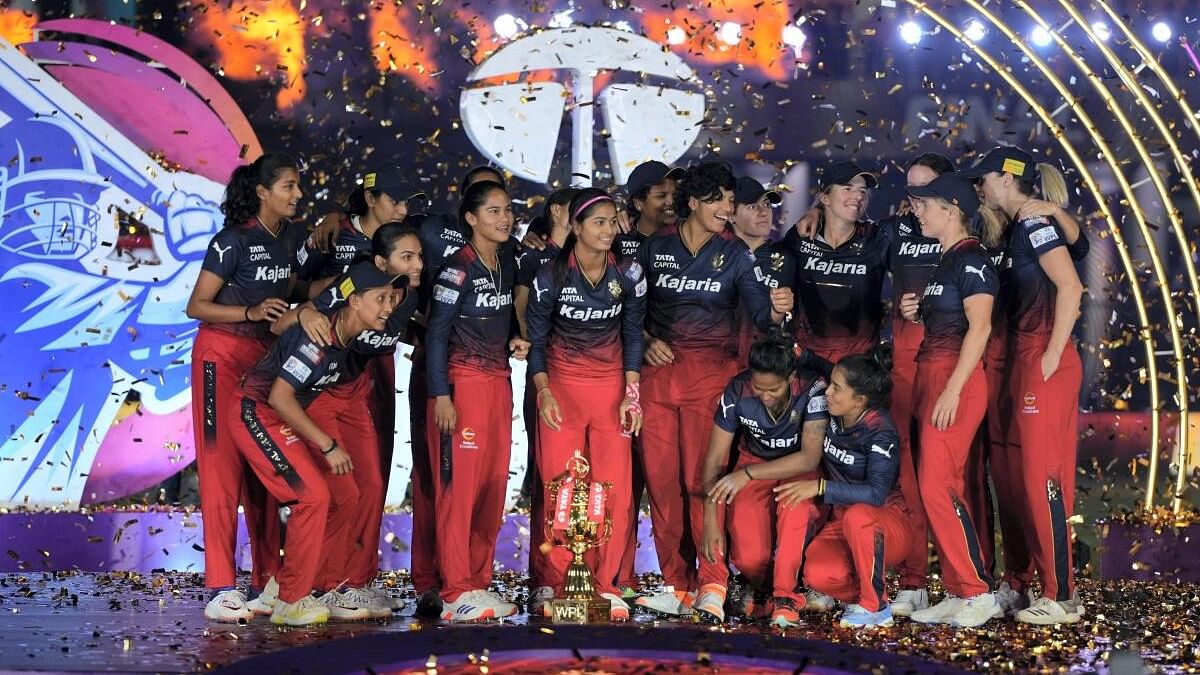
Royal Challengers Bangalore players pose with the trophy after winning the WPL-T20 final cricket match.
Credit: PTI Photo
The first-ever Women’s Cricket World Cup was played in 1973, and India missed the inaugural event because we did not have a women’s team then. India entered the tournament in 1978. Our women cricketers traveled in unreserved compartments, slept near the toilets of the bogies, and even paid ₹10,000 each to represent their country; they were also made to pay for their cricket kits. Fast forward to 2024, and women’s cricket has gained significant traction among sports enthusiasts. It is heartening to witness these champions displaying their best cricketing skills. At least now, they are not required to spend their own money.
Significant changes occurred when the Indian women’s team reached the finals of the 2017 ICC Women’s World Cup (50 overs). Diana Edulji, then an office-bearer of the BCCI and a pioneer in Indian women’s cricket, announced ₹50 lakh for each player for their efforts. She also pledged to double the amount if they won the finals. All she aimed for was the girls’ happiness and encouragement from the board. Though our girls lost the tense finale, the trajectory of change commenced that very year. With the launch of the WPL, a welcome change is evident, but is it sufficient? The question arises: How biased is the ecosystem towards women’s cricket and cricketers? While BCCI announced equal monetary compensations for its male and female contracted players, the reality remains that a woman cricketer cannot earn the same amount as a male cricketer through other avenues, with few exceptions. However, today, things are not as bleak. The WPL was launched with all its glitz and glamour. SRK danced at the opening, and it received media coverage. The league has concluded, and we have a winner: Smriti Mandhana lifted the trophy for RCB after a 16-year wait. But are we treating WPL winners with the respect they deserve? Or are we akin to the people who interviewed Kabir Khan at the beginning of Shah Rukh Khan-starrer Chak De! India? It is time to reflect on how the media covers the WPL champions.
Since RCB won the WPL title, the discussion has consistently revolved around Virat Kohli. Virat did not play in the finale for obvious reasons, yet the focus on him in most questions detracted from the players who brought the coveted cup to the team after 16 years. It was indeed a moment of joy for the fans. The media repeatedly made skewed comparisons between Virat and Smriti based solely on their jersey numbers, i.e., 18. Smriti Mandhana had to publicly request the media stop the comparison, emphasising that jersey numbers are just a personal choice. For a champion who led her team to victory after a 16-year drought, it must have been painful to address such an absurd comparison publicly. And this is the winning captain we are discussing. Shreyanka Patil, a wonderful right-arm off-spinner who took four wickets in the final and eventually held the purple cap, was interviewed by a leading news network, where the interviewer consistently referred to the ‘RCB Men’s Team’. While RCB’s women’s team speaks highly of Virat Kohli, rightfully praising him for his achievements, the fact remains that Virat was not even present in the stadium during the finale, yet he garnered all the attention. How can this be fair, by any stretch of the imagination? The team that won the trophy also deserves post-win limelight. We understand that men’s cricket attracts most sponsors and media attention, but sports journalists should have awareness and decency while covering women’s sports to give credit where it is due. The media cannot simply cling to a successful male cricketer who had no involvement in the win.
On July 12, 2017, Mithali Raj, the then captain of the Indian Women’s side, became the first batter in the history of women’s cricket to surpass 6,000 runs. Virat congratulated Mithali on Facebook, but tragically, he used the picture of Punam Raut instead of Mithali Raj. Virat even failed to recognise the face of his fellow champion female counterpart. Compare this to how India reacted when Maria Sharapova said she didn’t know who Sachin Tendulkar was, and then we have an Indian men’s team skipper failing to recognise another champion Indian cricketer, especially in Mithali’s 18th year as a cricketer.
The real credit for the success of women’s cricket goes to the likes of Diana Edulji, the first Indian woman cricketer to be inducted into the ICC Hall of Fame, for her efforts in creating more employment opportunities for female cricketers. The least we can do is mention her name repeatedly when the game has prospered manifold while she endured the struggle alone. N Srinivasan, former BCCI president, once told Diana to her face, ‘If I had my way, I wouldn’t let women’s cricket happen.’ There are real fighters who battled against the tide to create this ecosystem for female cricketers.
So, whose cup is it anyway?
(The writer is a student of Cinema, Screenwriter and
Creative Supervisor for the Kannada language for a major streaming service)